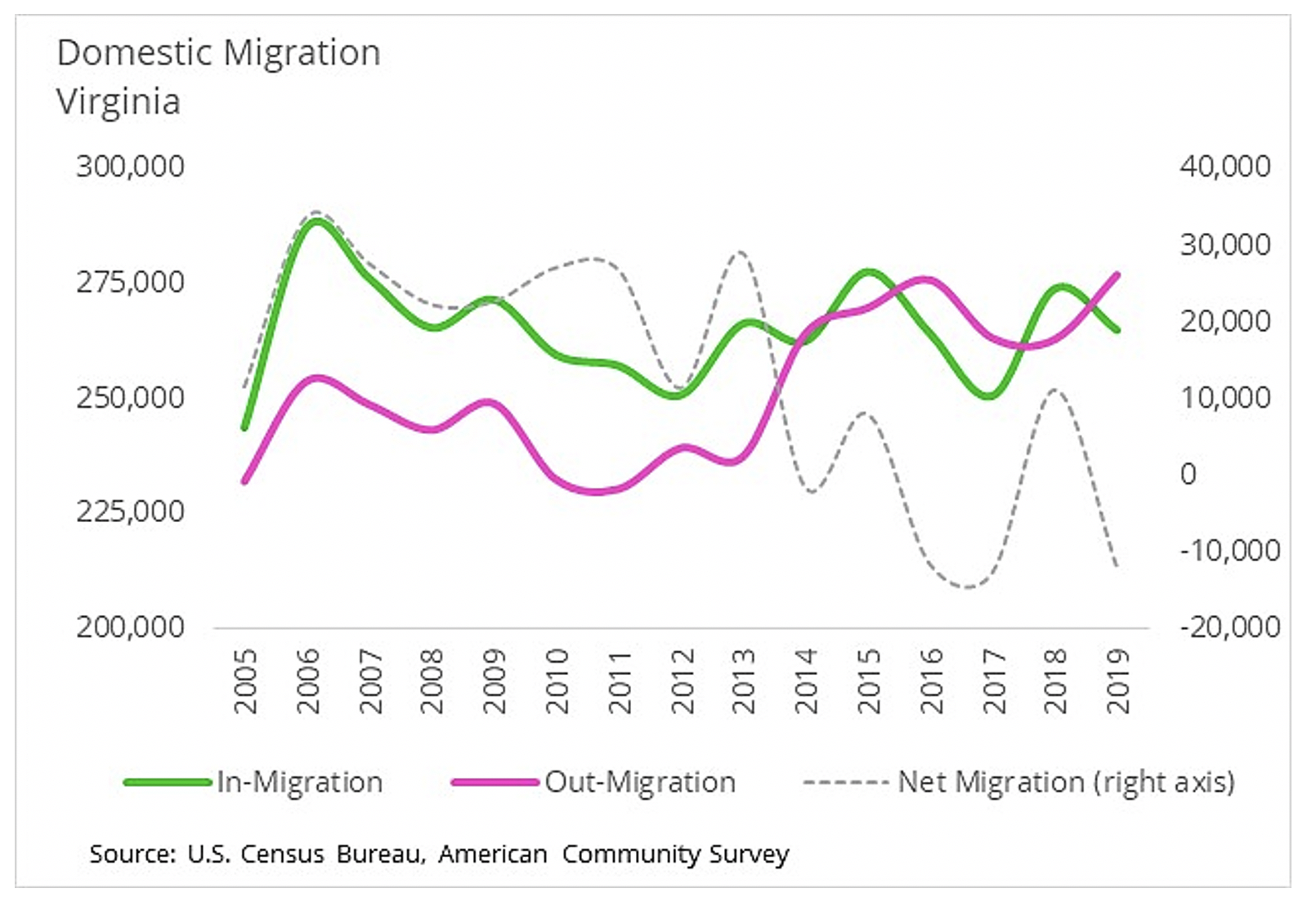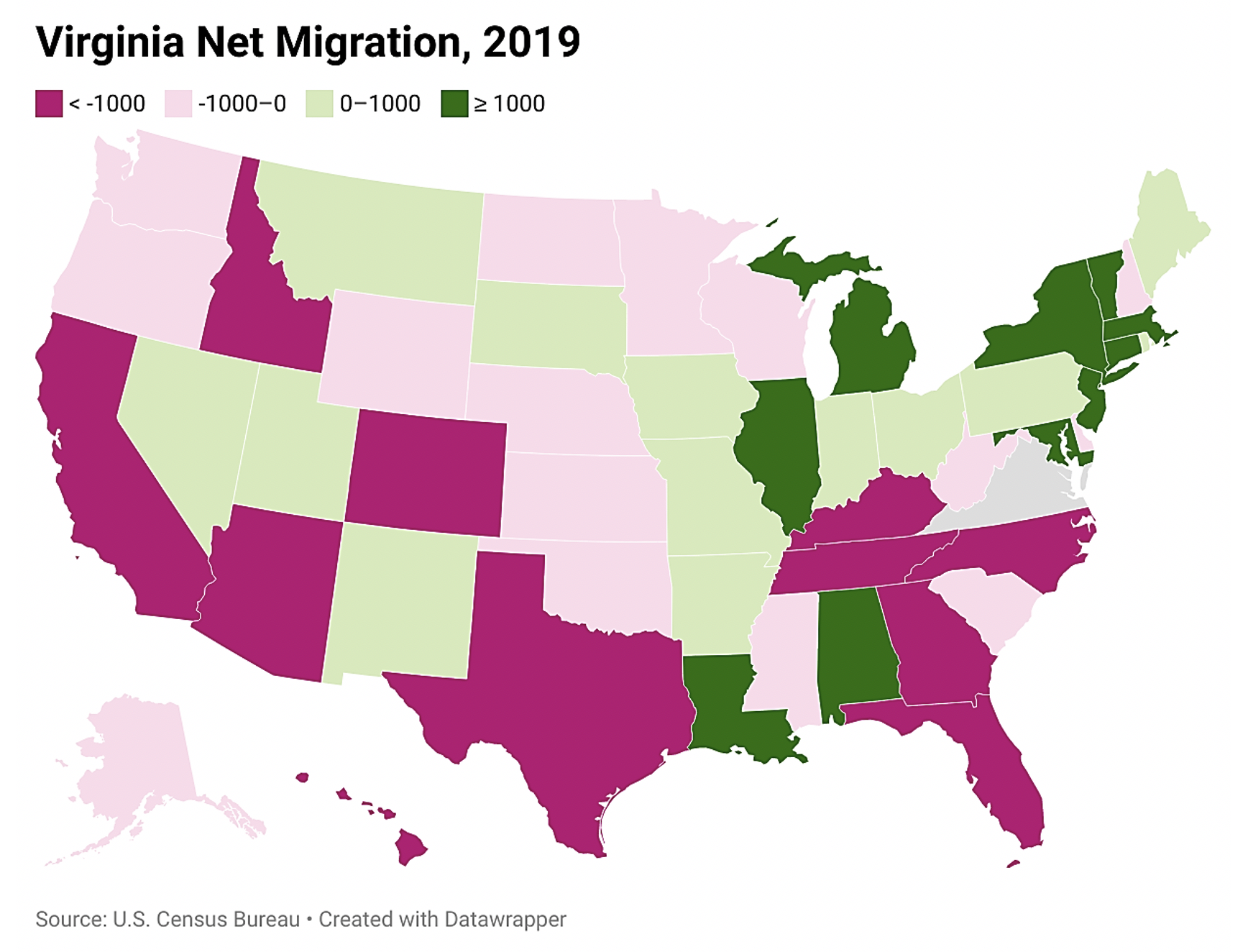Moving In, Moving Out: Virginia’s Migration Trends
August 5, 2021
A major driver of Virginia’s economic growth is the state’s ability to attract and retain new residents. Expanding domestic migration has become an increasingly important focus for growing the state’s economy, as well as for supporting a strong housing market.
Virginia’s Net Domestic Migration Likely Was Positive During the Pandemic
According to tabulations of change-of-address data collected by the U.S. Postal Service (USPS), between March 2020 and October 2020, net domestic migration in Virginia was 95, meaning that 95 more people moved into Virginia than moved out over that time period. The USPS data only tracks movers within the U.S.
The largest number of in-migrants to Virginia came from the District of Columbia. Tennessee, North Carolina, Texas, and West Virginia rounded out the top five states where new Virginia residents moved from between March and October of last year.
The District of Columbia was also the top destination for out-migrants from Virginia, which reflects the fact that most moves tend to be fairly local. Nearly a quarter of people moving out of the state between March and October 2020 moved to Tennessee. Smaller numbers moved to Maryland, North Carolina, and Florida.
Virginia Migration, 2020

Over the Past 15 Years, There Has Been a Trend of More People Moving Out of Virginia Than Moving In
While net domestic migration may have been positive (or at least flat) during the pandemic, there has been a longer-term trend towards more out-migrants than in-migrants. Virginia’s net migration turned negative in 2014, and between 2014 and 2019, there were four years of negative net migration and two years of positive net migration.
According to the most recent U.S. Census Bureau migration data, in 2019, an estimated 264,885 people moved into Virginia from other states and 276,849 people moved out of Virginia, resulting in net migration in 2019 of -11,964 people. In 2018, net migration was positive, with 11,185 more people moving into Virginia than moving out.

In 2019, more than 20,000 people moved into Virginia from Maryland, North Carolina, and Florida. California and New York round out the top five states where Virginians moved from.
In that year, North Carolina was the top destination of people moving out of Virginia, with nearly 30,000 Virginians moving to the Tarheel state. Florida, California, Maryland, and Texas were the other top five destinations for Virginia out-migrants.
Virginia Domestic Migration, 2019

Overall, Virginia’s net migration (i.e., in-migration minus out-migration) was positive with states in the northeast and a handful of states in the deep south and Midwest. However, in 2019, there was negative net migration with most states in the southeast as well as with many western states.

Outlook: Will More People Move to Virginia then Move Out?
The COVID-19 pandemic altered typical residential mobility patterns. In “normal times”, people usually move for employment or family reasons. Last year, there was evidence of individuals and families making lifestyle choices in the face of the public health crisis, many choosing to move to small and mid-sized regions and to suburbs and small towns. We saw some of this movement to smaller communities in Virginia last year, as home sales and prices accelerated in rural and suburban markets.
In 2021 and into 2022, in which hopefully we will be returning to a more normal, post-pandemic world, it is still unclear whether the housing and neighborhood choices people made last year will continue.
Virginia can be in a good position to attract new residents in the years to come, particularly if job growth accelerates and more companies choose to locate in the state. A constraint, however, will be the cost of housing in Virginia, with home prices and rents higher in many markets than they are in Virginia’s competitor states. Therefore, ensuring a sufficient supply of housing to meet the demand of new working families will be important for ensuring people will choose to make Virginia their home in the future.
Click here to send any comments or questions about this piece to Virginia REALTORS® Chief Economist Lisa Sturtevant, PhD.
You might also like…
Key Takeaways: September 2024 Virginia Home Sales Report
By Virginia REALTORS® - October 23, 2024
Key Takeaways Closed sales activity remains relatively flat compared to last year. There were 8,065 homes sold in September throughout the state, just 42 more than last September,… Read More
Single Family Homes Permit Activity in Virginia
By Dominique Fair - October 15, 2024
Supply has played a huge role in affordability issues for buyers, with the U.S. short 4.5 million units and sellers still holding on to homes with lower rates.… Read More
Mortgage Rates Come Down, Purchasing Power Goes Up
By Abel Opoku-Adjei - October 7, 2024
The moment everyone has been waiting for is slowly coming. One of the most significant indicators influencing potential buyers’ decision-making is mortgage interest rates. The average mortgage rate… Read More